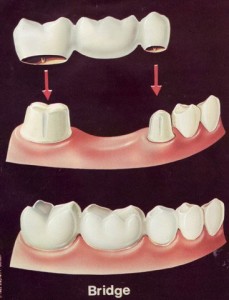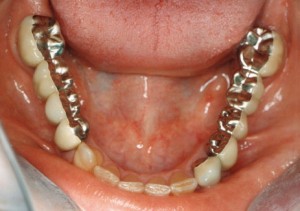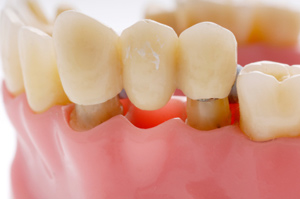The resin bonded bridge is primarily used for your front teeth. Less expensive, this bridge is best used when the abutment teeth are healthy and don’t have large fillings. The false tooth is fused to metal bands that are bonded to the abutment teeth with a resin which is hidden from view. This type of bridge reduces the amount of preparation on the adjacent teeth. Continue reading
Category Archives: Dental Bridges
Types of pontic Part 3
THE DE-EPITHELlALlZED CONNECTIVE TISSUE PEDICLE GRAFT (Roll Technique)
Basically, it is a form of contiguous grafting (pedicle graft} which utilizes as the donor site only the connective tissue of the palate adjacent to the ridge. The epithelium over the pedicle is first removed. This is readily done, using a non-epinephrine bearing anesthetic, by sharp dissection or by use of a rotary diamond instrument. Free bleeding, permitted by the non-epinephrine anesthetic, is evidence of complete epithelial removal. The tissue is then infiltrated with an anesthetic containing a hemostatic agent, and a connective tissue pedicle flap is outlined through to the osseous, and then elevated from the palate within the de-epithelialized zone. In this procedure, it is important that the proximal marginal tissue of the adjacent abutment teeth is not involved. This will ensure stability of the crown margin to tissue relationship. Continue reading
Types of pontic Part 2
Surgical Preparation of the Pontic Recipient Site
If the level of the healing ridge is too far corbnal for an esthetic pontic, the anatomical topography of the site must be determined by needle probing under local anesthesia. If there is a thickness of 3 or 4 mm of soft tissue above the alveolus in the center of the ridge, it is necessary only to perform soft tissue gingivoplasty, developing an anatomical configuration compatible with the two adjacent teeth. This is easily accomplished with a rotary diamond instrument. A 1 mm concavity for the base of the pontic, further apical to the maximal curvature of the adjacent marginal gingiva, is developed. To fit into this area, the temporary pontic is relined with self-curing acrylic, trimmed, and polished, allowing the tissue to heal around this ovate form. Continue reading
Types of pontic Part 1
In those clinical situations in which missing teeth are replaced with fixed prosthodontics, the clinician is faced with the task of fabricating the pontics to fulfill the requirements of esthetics, form and function, and oral physiotherapy. Continue reading
Failures In Bridge/Fixed Partial Denture
FAILURES IN FIXED PARTIAL DENTURE
A bridge is a custom-made device anchored to neighboring natural teeth, which replaces one or more missing teeth. When a lost tooth is replaced with bridgework, the teeth on either side of the missing one are prepared as crowns to hold the bridge in place. Bridges, sometimes referred to as a fixed partial denture, look natural and literally bridge the gap where one or more teeth may have been. Fixed bridges appear and function similar to natural teeth.
Buying Dental Gold
Dental scrap gold is fast becoming an additional resource for people wishing to sell gold. Dental scrap gold consists of any gold that has been used in the mouth and is worth more sold than kept. It can include any failed, damaged or deteriorated gold or silver crowns, any bridges, PFM’s (porcelain fused to metal), PFG’s (porcelain fused to gold), Inlays, Gold Partials and more. In fact here is a list of the dental scrap including gold, silver and platinum that can be sold, and these can be with or without bone or porcelain: Continue reading
Root Canal Treatment vs. False teeth
    When there is a cavity in a tooth, you can have it filled; but what happens if caries has spread deep into your tooth, such that your tooth is infected beyond salvage point? There are several options that you may go for:
How Long Do Dental Bridges Last?
The common question one would ask a dentist after a dental restoration would be, ‘How long would this last?’ Dental restorations do not come cheap therefore many would want to be reassured that their money is well invested in something that would, desirably, last a lifetime. However, nothing is permanent. Continue reading


